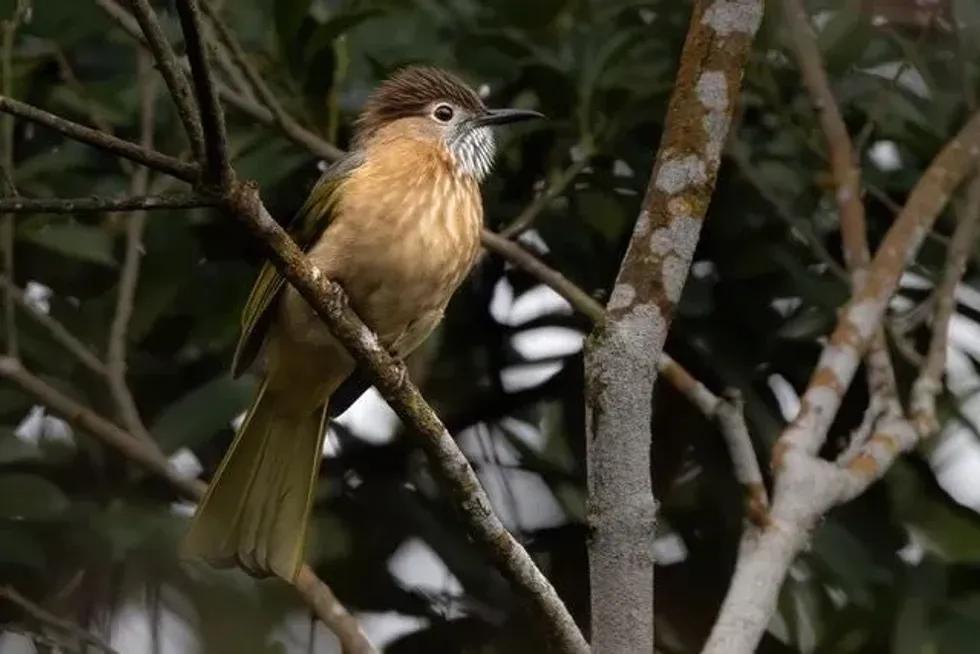The mountain bulbul (Ixos mcclellandii) is a type of bird that belongs to the Ixos genus. The mountain bulbul, Ixos mcclellandii (Horsfield 1840), belongs to the class of Aves.
Horsfield (1840) classified this bird under the family of Pycnonotidae. The mountain bulbul habitat primarily consists of evergreen lush broadleaved forests, oak forest, rhododendron forest, and pine forest.
This bird is found at elevations of 2,625-8,858 ft (800-2,700 m). The range and distribution of the Ixos mcclellandii are in south-eastern Asia and parts of India, the Himalayas, and Myanmar. They are primarily found in southern China and southern Vietnam.
The taxonomy of this bird's phylum is chordate. These birds are quite common and the conservation taxonomy of these birds is Least Concern.
These birds have a large range and do not approach the thresholds for Vulnerable in any way. A few other species that belong to a similar family of the mountain bulbul are the tickelli, the similis, and the peracensis.
Read on to discover more fun facts about the mountain bulbul! For more relatable content, check out these blue jay facts and ani bird facts for kids.
Mountain Bulbul Interesting Facts
What type of animal is a mountain bulbul?
The mountain bulbul (Ixos mcclellandii) is a type of bird that belongs to the Ixos genus and the animal kingdom.
What class of animal does a mountain bulbul belong to?
The mountain bulbul (Ixos mcclellandii) belongs to the class of Aves. Horsfield (1840) classified this bird under the family of Pycnonotidae.
How many mountain bulbuls are there in the world?
It is not possible to determine the exact number of mountain bulbuls that exist in the world today. The conservation taxonomy of these birds comes under the red list category of Least Concern.
These bulbul birds have a large range and do not approach the thresholds for Vulnerable in any way. This species has a wide range of distribution in south-eastern Asia and parts of India, the Himalayas, Myanmar, and Thailand. They are primarily found in southern China, southern Vietnam, and some parts of Indochina.
Where does a mountain bulbul live?
The mountain bulbul is found in evergreen lush broad-leaved forests. This species is only found in mountain regions where there are abundant green forests and cool temperatures.
The mountain bulbul range is quite large. The range and distribution of the Ixos mcclellandii (Horsfield 1840) are in south-eastern Asia and parts of India, the Himalayas, Myanmar, Thailand. They are primarily found in southern China and southern Vietnam.
What is a mountain bulbul's habitat?
The mountain bulbul habitat primarily consists of evergreen lush broadleaved forests, oak forest, rhododendron forest, and pine forest. This bird is found at elevations of 2,625-8,858 ft (800-2,700 m). The range and distribution of the Ixos mcclellandii are in south-eastern Asia and parts of India, the Himalayas, and Myanmar.
They are primarily found in southern China and southern Vietnam. The taxonomy of this bird's phylum is chordate and these birds prefer cool and low temperatures.
This species has nine subspecies, and these nine subspecies are typically found along with the Ixos mcclellandii. This species feeds on fruit, seeds, nectar, small insects and other arthropods, and even small vertebrates. They live with the company of other birds.
Who do mountain bulbuls live with?
Mountain bulbul (Ixos mcclellandii) birds are typically found in pairs, small groups, or a small flock. The flock tends to have family parties and serve as company to one and another and often include juveniles. This species is mostly monogamous and highly territorial. They stay in a flock or group that defends a large home range together.
How long does a mountain bulbul live?
The mountain bulbul (Ixos mcclellandii) has an average lifespan of 11 years in their natural habitat. They can live for far longer if kept captive and provided with the right type of bird feed and environment.
How do they reproduce?
The breeding period of the Ixos mcclellandii bird is a distinct breeding season that occurs during the monsoon or rainy season. This species lays an average of two to three clutches of eggs every season.
The mountain bulbul eggs have a high rate of nestling loss. Nearly 70 % of the eggs laid do not hatch and 53% of nestlings do not survive.
Bulbuls have an extended period of parental care of the fledgling. They are highly unlikely to raise more than one brood in each breeding season.
The breeding season typically lasts from May to August in north-eastern India, February to March in northern Thailand, and March to September in the Malaysia Peninsula. The breeding season typically ends in early August.
This bird species lays its eggs in a clean nest that is a work of art. The nest is placed above the ground level but often much lower down in undergrowth at the evergreen forest edges. The nest is sometimes hung from the rim between thin twigs of horizontal fork near tree or bush, or sometimes even bamboo.
What is their conservation status?
The conservation status of the mountain bulbul bird is Least Concern because these birds are quite common. The conservation taxonomy of these birds is Least Concern and according to scientific data, these birds have a large range and are not currently approaching the thresholds for the Vulnerable status.
Mountain Bulbul Fun Facts
What do mountain bulbuls look like?
The common mountain bulbul bird has a sharp beak. According to scientific data, the Hypsipetes mcclellandii bird can be described as olive-green in color overall with a light buffy lower half.
Its throat is rufous streaked gray and its head appears to be crested. Due to its similar in size and few features like its pale throat gives it a similar appearance and resemblance to the chestnut bulbul. However, the mountain bulbul has a long bill and a pale face appearance that makes it easy to be recognized.
It is round-bellied with soft gray feathers. The mountain bulbul appearance is quite unique and appealing.
How cute are they?
Mountain bulbuls (scientific name Ixos mcclellandii) are quite adorable little birds. All the species and subspecies of this phylum are very cute. The mountain bulbul flying is one of its prettiest acts.
How do they communicate?
The Ixos mcclellandii (or Hypsipetes mcclellandii) flocks are loud. A group of this bird species is easily detected as they fly overhead. They are known to give out sharp, repetitive, echoing calls that can be likened to 'zyi-zya' or 'zya-zya'. Their song is a prolonged, repetitive, and continuous series of call notes.
How big is a mountain bulbul?
The mountain bulbul is only 7.1 in (18 cm) long and is considered to be a very lightweight bird. They can be described as lightweight swift birds and are bigger than the common bulbul.
How fast can a mountain bulbul fly?
Ixos mcclellandii are swift flying birds. The exact data of speed of these birds has not yet been determined, however, these birds are never seen sitting in one spot for too long. They are always flying, hunting, or building nests with their groups. Data regarding the mountain bulbul wingspan is unknown.
How much does a mountain bulbul weigh?
The round-bellied mountain bulbul weighs only 1.1 oz (30 g) and it is a bit smaller than the cape bulbul. It is a very lightweight bird and it can fit in the palm of your hand and can be carried easily.
What are the male and female names of the species?
The mountain bulbul male and mountain bulbul female do not have any specific names. They are both called Ixos mcclellandii and belong to the Passeriformes order of birds.
What would you call a baby mountain bulbul?
The mountain bulbul baby is called a chick. They are even called hatchlings after the eggs hatch.
What do they eat?
The mountain bulbul diet primarily consists of fruit, seeds, nectar, small insects like ants and other arthropods, and even small vertebrates.
Are they dangerous?
No, Ixos mcclellandii birds are not harmful to humans or nature in any way. These birds are very tiny and enjoy staying in their small group. However, sometimes the mountain bulbul fight their own species when aggravated and during the breeding season.
Would they make a good pet?
Even though the Ixos mcclellandii make engaging pets, and in parts of Asia are kept and treated similar to parrots, it is not a good idea to keep these birds as pets. Birds love the open environment where they can freely flutter around with their company of other Ixos mcclellandii and sing.
This type of environment can not be provided artificially in homes.
Did you know...
This bulbul species of Ixos mcclellandii is originally from Africa, the tropical Asia peninsula, and the Middle East.
A few other species that belong to a similar family of the mountain bulbul are tickelli, similis, and the peracensis.
Do mountain bulbuls migrate?
Yes, the mountain bulbul migrate in small flocks. This species typically migrates when the temperature in their range goes up and becomes unsuitable for them to stay in.
Are mountain bulbuls endangered?
This species has an extremely large population and has been listed under the taxonomy of Least Concern category. They are not approaching the thresholds for the Vulnerable category. These birds have a stable population and do not seem to be endangered.
Here at Kidadl, we have carefully created lots of interesting family-friendly animal facts for everyone to discover! Learn more about some other birds from our eastern kingbird interesting facts and northern parula fun facts pages.
You can even occupy yourself at home by coloring in one of our free printable geometric owl coloring pages.
Thank you to Kidadler Robert Ferguson for providing the images of the Mountain Bulbul in this article.









